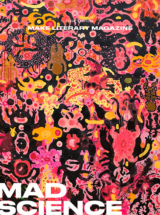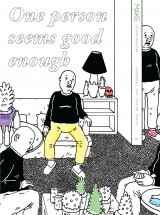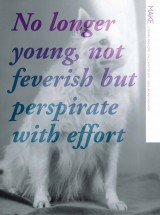
by Barrie Jean Borich

The first thing I can remember reading—and I don’t mean just comprehending, just translating printed marks on a page into words, but really reading—is an article in Ranger Rick magazine.
The year was probably 1979 or ’80. Ranger Rick, as you may know, is a nature magazine for kids, put out by the National Wildlife Federation; this article appeared in one of their October issues. I seem to recall a photo of an owl on its cover. My younger brother had recently come by a difficult-to-explain terror of owls, and I suspect that his terror—and the fact that I did not share it—gave this particular issue an additional aura for me: seductive, mildly dangerous.
This was a different era, prior to the ascendancy of Christian fundamentalists to various state boards of education, when it was still possible to design a Halloween-themed issue of an avowedly pedagogical magazine without jeopardizing its chances for classroom adoption—and this issue of Ranger Rick was unapologetically Halloween themed. The earnest humanists of the National Wildlife Federation had, however, shorn it almost entirely of the customary seasonal signifiers of the occult: no witches, no werewolves, no ghosts. At age seven or eight I was already cultivating a fascination with occult signifiers; if I was aware of these editorial omissions, I can’t have been pleased by them.
The article that I remember—the one that has stayed with me, however changeably, across thirty years—was written by a woman, a mother, and described a Halloween activity performed at her family’s lake house by her children and her children’s friends. Something about the piece struck me immediately as strange: the perspective from which it was told, the point of view, the narrator’s voice—although of course I had no access to these concepts, basic components of the writer’s toolkit. I only knew that I wasn’t used to Ranger Rick addressing me in the voice of a particular adult, someone involved in the story she was telling. The article was a little longer, too, than the typical Ranger Rick piece, and a little harder to read: not over my head, but not talking down, either. The encounter felt like a mistake, like a door accidentally left open, like I might not really be the intended audience.
The content I understood well enough, or thought I did. I knew, for instance, what a lake house was. I read this and every other issue of Ranger Rick while staying with my maternal grandparents in the Piney Woods of East Texas, some sixty miles north of my own suburban home; my brother and I were sent up there often—gaining healthy exposure to “Nature,” keeping temporarily out of our parents’ hair—and we were generally happy to make the trip. My grandmother had purchased the Ranger Rick subscription with the goal of keeping us quietly entertained during our visits, and after sundown it came in handy; during daylight hours, the ten forested acres of sandy bottomland on which my grandparents’ house was built more than sufficed to hold our attention. On top of that, a few times a year my grandfather would roll his small fiberglass boat from its shed, clear the dirt-dauber wasps’ nests from the intakes of its Mercury outboard, and tow it up the road to Lake Conroe, where we’d spend a day fishing for bluegills, crappie, and channel cats.
Like virtually every other large body of fresh water in the Lone Star State, Lake Conroe is not, strictly speaking, a lake: it’s a reservoir, created in 1973 by the damming-up of the west fork of the San Jacinto River, which makes it two years younger than I am. I didn’t know this at the time. It would not have occurred to me that this inexhaustible source of mystery—a mile across, fifteen miles long—could have been brought into being by human hands. I liked to imagine the lake as a living thing, possessed of its own intelligence: every weighted hook we cast seemed an attempt at communion, charged with the prospect of discovery. While my grandfather spent the morning arranging our tackle to produce calculated results—juglines and stink-bait for catfish, bobbers and nightcrawlers for perch—I would crank my reel in constant hope of the unexpected. At depths greater than about a foot the water was opaque, glossy and greenish-black like a live-oak acorn, and it seemed capable of concealing anything. A mud turtle’s nose poked between lily pads, a hook tangled in feathery hydrilla, even snags that forced the snapping of a line: all these might be taken for omens.
At midday we’d reel in and motor to a shady spot to eat tuna-fish sandwiches from the cooler, and that’s typically when I’d consider the houses that lined the banks. Many were outfitted with tiered decks, whitewashed gazebos, speedboats moored to private piers; some were raised on stilts to guard against flood. I don’t recall ever being envious of these lakeside dwellers—my family was upwardly mobile; none of this seemed out of reach—but the thought that people might actually reside here, at the edge of such limitless chthonic wonder, filled me with excitement and awe. I imagined these folks as anchorites, as oracles, who’d don their flip-flops and proceed to the docks by dawn to assay what the dissipating mists might portend. The available evidence, of course, suggested that their interests ran more toward water-skiing, angling for largemouth bass, and sucking down shit-tons of Lone Star beer—but even at that age, I was guided by the sense that resisting the obvious interpretation is a pretty good way to maintain an enchanted existence.
Looking back, I’m pretty sure the lake in the Ranger Rick article resembled Lake Conroe hardly at all. I seem to recall a reference in the woman’s story to an early frost; the accompanying photographs showed rocky hillsides aflame with maples. The Piney Woods, by contrast, never supplied much in the way of autumn color. Furthermore, it’s likely the Halloween issue of Ranger Rick reached me in early September, when the weather in East Texas was still ninety degrees and miserably humid, which probably explains why I was indoors reading the magazine in the first place.
This, as well as I can remember, is the story the woman told:
She, her husband, her children, and her children’s friends gathered at the lake house on Halloween to make jack-o’-lanterns. They used pumpkins of various sizes as well as other, more exotic winter squash—cushaws, turbans, acorns, hubbards—all purchased from a farm stand earlier that day. The children drew wild faces on the squash-skins; the adults carved them. This took all afternoon. While the woman and her husband worked, the kids went into the woods to gather fallen branches; once the jack-o’-lanterns were finished, the group lashed the branches together to fashion crude rafts. The sun went down. The hollowed squash were lined up along the dock, lit from within by votive candles. Spooky stories were told until the hour grew late. Then, with some formality, the jack-o’-lanterns were put on the rafts and towed by canoe some distance from shore, where the wind caught them and they began to drift. The children watched as the ghoulish faces they’d made flickered orange across the water—each doubled by its own unsteady reflection—until all were gone from sight. Then they slept. Periodically, for weeks afterward, the woman and her family would find tangled bits of raft and soggy chunks of pumpkin at the water’s edges; by summertime, squash vines had begun to leaf along the lake’s banks, sprouted from occasional seeds the family had left in the drowned jack-o’-lantern skulls.
When I read this account at age seven or eight, I thought it was by far the best thing I had ever heard of anybody doing. I could not have begun to explain why I felt this way—it’s not much easier to pin down now—and something in the woman’s tone gave me the pleasing and thrilling sense that she, too, was baffled by the whole endeavor. It sounded like a ton of fun, but creepy, too, and a little dangerous. As I’ve thought about the article over the years, I’ve scanned my memory fruitlessly for clues as to whether the family’s jack-o’-lantern regatta was a spontaneous gesture (i.e. creepy and dangerous in a Heart of Darkness, Lord of the Flies kind of way) or if it was a premeditated ritual (i.e. creepy and dangerous in an Aleister Crowley, Wicker Man kind of way). Whatever its conception may have been, it was entirely appealing to me.
But why, exactly? Partly, of course, it was the sense that these folks had kicked my bush-league fishing-trip animism up to the advanced level: they’d abolished any pretense of material functionality—fish for dinner!—and plunged headlong into a realm of atavistic magic. I mean, I’d participated in the carving of jack-o’-lanterns before; it was sort of a pain in the ass. The labor these people must have expended, only to send their handiwork into the lake as soon as it was done: this struck me, rather compellingly, as a complete waste of time and effort.
But not a pointless waste—which is, for instance, what going to church seemed like to me. This was no comforting and conventionalizing ritual, long-established by tradition. Instead, this was alchemy: an improvisatory adventure that risked both silliness and perdition, a ceremony conducted for the purpose of determining the purpose of the ceremony. That, I thought, was pretty cool.
And yet that wasn’t the half of it. The image that the article lodged most firmly in my mind was not, finally, that of the jack-o’-lanterns floating away from the family’s dock. Rather, it was the view I imagined from the opposite bank: what someone in one of those lake houses might have seen. It was that person—unmentioned in the woman’s story, purely my own invention—whom I took as my surrogate, and whose point of view it pleases me even today to inhabit: someone stepping from the music and chatter of a Halloween party, maybe a little drunk, wandering—alone, or in intimate company—down to the docks to watch the moon silver the water, and glimpsing there, through a cloud of chilled breath, that line of orange demons as it came across the lake.
For some time prior to my encounter with the Ranger Rick article, I had been fascinated and frustrated by the romantic cliché of messages in bottles: communiqués cast upon the waves for unknown persons to discover. This seemed like a great idea, except for one thing, namely: What message do you put in the bottle? Whatever might be written on the rolled scrap of paper, the true content was always predetermined and always the same: I wrote this. You found it. The genius of what the woman and her family had done consisted precisely of their refinement of this trick: they had replaced the bottles with jack-o’-lanterns, and the content of the message was identical to the act of delivering it.
I would like to be able to point to this as the moment when I realized that I wanted to “be a writer,” but that’s not accurate. Instead, I think of it as the moment when I began to understand how reading and writing actually function. To people such as myself, raised in an indisputably televisual culture, the printed page cannot help but seem about as quaint as a hoop skirt, surpassed as it has been by a dozen or more generations of fresher communicative technologies. How sad, say the apologists of the written word, that reading’s stately and difficult pleasures have been shunted aside by information and amusement served up on pretty screens that engage the audience in a manner so immediate and vivid—if also shallow, and often false—that they have no prayer of competing. That argument’s not completely wrong, I guess, but it also misses the point: these days, recourse to the printed page is not merely quaint, but actually perverse. Like any worthwhile perversions, reading and writing are defined by consensually imposed restrictions, tensions of frustration and deferral. The universally cited limits of written communication—pure language, received in silence from someone absent—are limits, sure enough, but they’re also precisely what makes reading and writing possible as imaginative arts. You craft an object from the materials you’ve collected; you try to fix something in it to shed a little light; you float it into the world across a featureless and mutable surface. Whatever audience finds it won’t know you, and you won’t know that audience: the value of what you’ve made is multiplied by this mutual invisibility. This is what it means to be an author. When it works—if it works—this is how.
What I believe I discovered in that issue of Ranger Rick—the thing of enduring value that I surely had no grasp of at the time but that I have returned to regularly in the intervening years as a tool and as a landmark—was basically this: an open and expansive attitude about existing in the world that didn’t come at anybody’s unconsented expense. The extravagant purposelessness of what the woman and her family did on that Halloween night seemed a vast leap beyond (and maybe a friendly rebuke to) the usual human-scaled ambitions of the National Wildlife Federation, with their earnest catalogues of species, diets, behaviors, and habitats; at the same time, it was a responsible and intellectually honest alternative to the neo-pagan romanticism that I toyed with while afloat in Lake Conroe. I don’t wish to be overly dramatic here, but this is a distinction that matters: one can follow the first road, if one is disposed to do so, into charmless realms of utilitarian technocracy; the second road, of course, passes through some pretty spectacular scenery on its way into the kingdom of fascist mystification. When we come by our values in childhood, it’s difficult to know exactly what’s at stake, or when it’s too late to stop believing our own bullshit.
There is another path; I suppose there always is. What we believe and what we consider to be true can, for a time, be bracketed: we can step out of ourselves, out of our entanglements, and see our circumstances anew. We call this make-believe; we call it playing a game. Sometimes we call it art, or fiction.
The sun is down; we’re all gathered in the dark. Someone puts on a mask, tells a tale in a strange voice, lifts hands toward the fire to throw shadows on the wall. We know the storyteller, or we think we do, but we can’t make out the familiar face, and now the hair begins to rise on our scalps: the thrill of dreaming freely in this fragile space we’ve made, this zone of relative safety where—without serious consequence—we can take a moment to play tricks on ourselves.
Martin Seay’s writing has appeared in MAKE, Joyland,Gargoyle, and the Gettysburg Review. He lives in Chicago with his spouse, the writer Kathleen Rooney, and maintains the weblog New Strategies for Invisibility.















click to see who
MAKE Magazine Publisher MAKE Literary Productions Managing Editor Chamandeep Bains Assistant Managing Editor and Web Editor Kenneth Guay Fiction Editor Kamilah Foreman Nonfiction Editor Jessica Anne Poetry Editor Joel Craig Intercambio Poetry Editor Daniel Borzutzky Intercambio Prose Editor Brenda Lozano Latin American Art Portfolio Editor Alejandro Almanza Pereda Reviews Editor Mark Molloy Portfolio Art Editor Sarah Kramer Creative Director Joshua Hauth, Hauthwares Webmaster Johnathan Crawford Proofreader/Copy Editor Sarah Kramer Associate Fiction Editors LC Fiore, Jim Kourlas, Kerstin Schaars Contributing Editors Kyle Beachy, Steffi Drewes, Katie Geha, Kathleen Rooney Social Media Coordinator Jennifer De Poorter
MAKE Literary Productions, NFP Co-directors, Sarah Dodson and Joel Craig